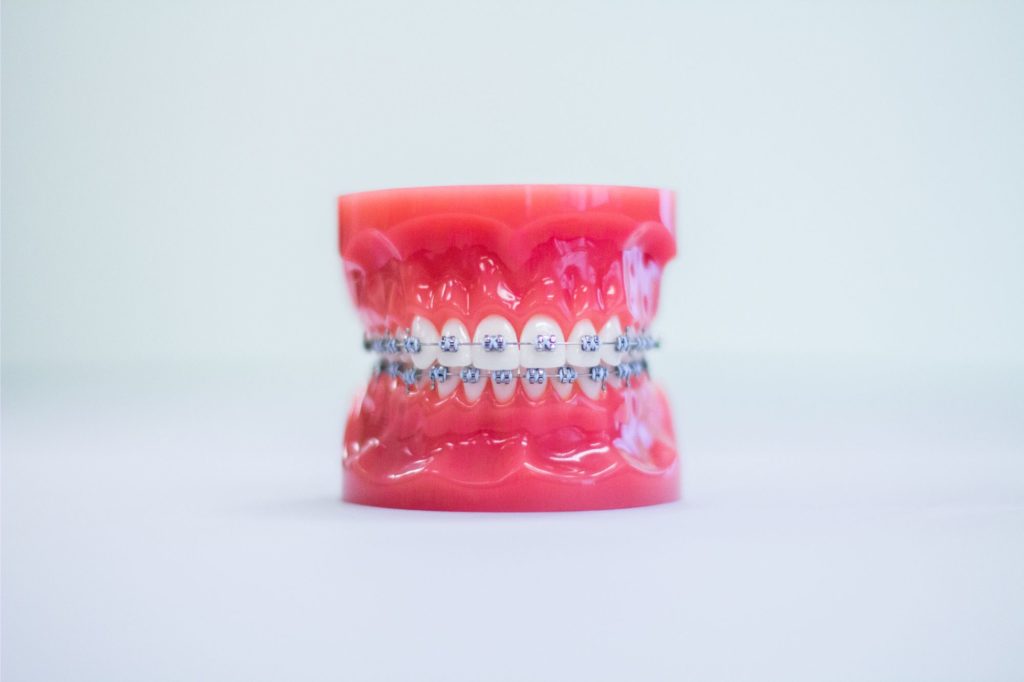
Trusted Treatment
Traditional braces have been around for a long time, and they’re probably the most recognizable symbol of orthodontics.
These orthodontic workhouses have a long history of successful treatment and are great at correcting many oral issues.
What Are Braces Made Of?
Brackets
The brackets are durable and made from a mix of stainless steel, nickel, and other metals.
Brackets have little hooks or doors where a wire is threaded. A bracket can be secured by closing the door, or by placing an elastic over the top of the wire.
Glue
This is what Dr. Shaw will use to attach the brackets to your teeth. It’s common to attach the bracket directly to the tooth with glue.
Wire
This thin piece of metal runs from one bracket to another. Dr. Shaw will change the shape and curvature of the wire to move your teeth in the right direction.
The wire will attach all of your bottom or upper teeth together in many cases, but we might occasionally cut the wire if connecting just a few teeth is better for your treatment plan.
Elastics
If you need bite correction, elastics are essential. They are generally strung between an upper bracket hook and a lower bracket hook. This will pull the upper jaw backward to correct an overbite, or the lower jaw back to correct an underbite.
We may use rubber bands for many different situations, especially when we want to put extra pressure on the teeth or jaws.
Orthodontic Bands
These are stainless steel rings that are cemented to your teeth using dental bonding agents. These bands can provide an anchor for your braces and orthodontic appliances, but they are not used for everyone.
Spacers
These small elastic “donuts” or rings can be used to create space in between your teeth when needed, typically before bands are placed. They are also referred to as separators.
Elastic Ties/O-Rings/Ligatures/Colors
These tiny rubber rings or bands are used to attach the archwire to the brackets. They’re less rigid than spacers and come in dozens of colors.
Metal Braces FAQ
Before applying the brackets, Dr. Shaw and our team will collect photos and X-rays of your mouth. Sometimes we will use our iTero Element scanner to scan each of your teeth and the layout of your gums and mouth. If necessary, this process takes 10-15 minutes and provides an extremely accurate 3D view of your mouth.
After the X-Ray and optional scan, the information will be used to help create your customized treatment plan. This will include how each tooth needs to be moved to get it in the best possible position.
Dr. Shaw will decide how to place the brackets based on this information. For example, if you have some teeth that need to be tilted, the placement of those brackets will be different than the placement of brackets for teeth that need to be turned.
Once the brackets have been attached, Dr. Shaw will insert the wire. Bends in the wire will provide different types of pressure on different teeth. A bend in the wire is how most orthodontists cause specific and precise movements.
For example, a bend can help a tooth that is twisted to turn and face the right way, or aligning one tooth that is too far forward with one that is too far back. This process of tooth movement is called remodeling, and it involves minor changes in the bone that surrounds the roots of your teeth.
What can I expect from today’s metal braces?
Metal braces have had a reputation for being awkward and obvious, but because of modern orthodontics, you will benefit from versions that are smaller, less conspicuous, and more comfortable than ever before.
Sleeker brackets and lighter wires improve the appearance and feel of these braces. This means you will have less irritation in your mouth.
Traditional metal braces also come with a fun new twist without any extra cost - you can customize them with pops of color. The elastics that fit around your brackets come in a wide variety of colors that let you showcase your personality whenever you want.
Pick your favorite color combination, the colors of your favorite sports team, even your school colors! We also offer silver, gray, white, black, and tooth-colored elastics for patients seeking a more subtle look.
Braces are great at fixing complex tooth issues. They can work faster at closing gaps and aligning teeth than other treatments might. This can potentially shorten your treatment time.
Metal braces are a cost-effective option because they don’t require some of the more complex technology or expensive equipment that newer treatments do. The strength, durability, and affordability of traditional metal braces keep them the top treatment for orthodontic patients, year after year!
This is what everyone wants to know, but it’s one we don’t have a concrete answer for. Every mouth is different, and every patient responds to treatment in their own way. Treatment time with metal braces will be different every time.
The average time spent in metal braces is around 18 to 22 months but could be shorter or longer, depending on the individual. We have patients in braces for as little as six months. But for complex issues, it can take over three years to complete the process.
With metal braces, you can see signs of improvement in just a short period of time, and that gives you confidence during the treatment process.
